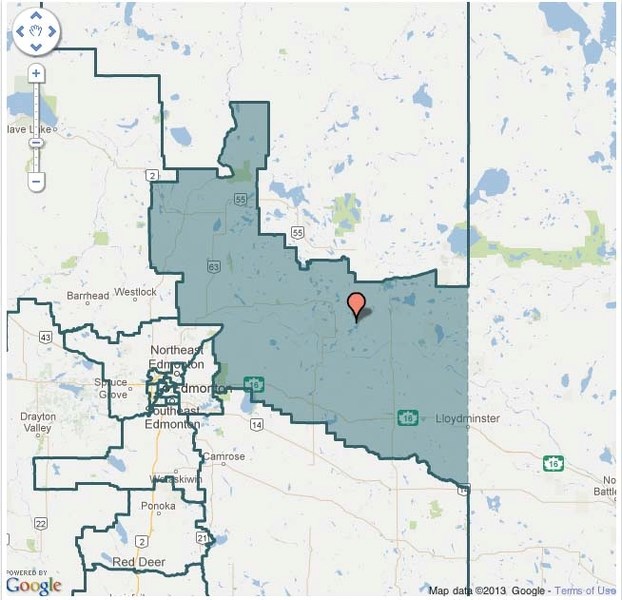The federal riding of Westlock-St. Paul will cease to exist if the recommendation of the Federal Electoral Boundaries Commission for Alberta is approved. The commission submitted its report redrawing the province's electoral map to the Chief Electoral Officer of Canada and it was tabled in the House of Commons in early December.
Six new electoral districts in the province are being recommended and reflect the population shifts since the 2001 census. A recommended redistribution of Alberta's 34 electoral districts will see all the existing boundaries change.
The proposed new Lakeland riding will include the communities and surrounding areas of Athabasca, Thorhild, Smoky Lake, St. Paul, Glendon, Bonnyville, Vermilion, Lloydminster and Vegreville.
Essentially, the new Lakeland riding boundaries will stretch from the Alberta/Saskatchewan border west to the Lamont county and north to Athabasca.
The commission extended the southern boundary of the Peace River riding to include Westlock. While Cold Lake, currently part of the existing Westlock-St. Paul district, will move into the new district of Fort McMurray-Cold Lake.
The MD of Bonnyville will be divided by the realignment of the boundaries, putting a portion of it in the Fort McMurray-Cold Lake riding and a portion in the Lakeland riding. The recommended boundary between the two is pretty much along Secondary Highway 660, however, there is some hope that will be moved further north to Highway 55.
Westlock-St. Paul MP Brian Storseth said as it is proposed, the Lakeland riding boundary would include the Village of Glendon, but many of the rural landowners who consider themselves Glendon area residents would find themselves in the Fort McMurray-Cold Lake riding. The concern with that is those people who currently vote at a polling station in Glendon would find they have to travel further to vote.
Storseth is optimistic that the Lakeland boundary can still be pushed up to the Beaver River or Highway 55. The City of Cold Lake, Town of Bonnyville and Village of Glendon support it.
“That was with the agreement of every municipality and political party other than the NDP and the MD of Bonnyville. The MD of Bonnyville didn't want to make the decision as to where the line goes, they would just as soon the whole MD stay together, which is understandable. And, we just simply couldn't get a hold of the NDP around here.”
MD Reeve Ed Rondeau said the preference of the MD council is to see the MD in one riding, preferably Lakeland. However, given that it is unlikely that will happen, he said council did not want to make the decision as to where the divide within the MD should be.
“We didn't want to be the ones saying divide it along 55 or divide it along 28. We just said then whatever the commission decides then it will have to be. The commission is the authority that decides where the boundaries are going to be.”
Rondeau is optimistic that having the MD spread across two ridings could actually be a benefit.
“It could be an advantage to have two MPs because you could literally be doubling up on the same (federal) programs. In the new budget the feds have put that infrastructure program in and I think that's going to be huge to helping out the municipalities,” Rondeau said. “As soon as we know where our boundaries are we can literally apply for a project north of the line and one for south of the line.”
Storseth said it is not the MP's role to get too involved in the designation of where boundary lines should be place because it can be seen as a conflict of interest.
“What I did do this summer is go to each of our councils that would meet with me and just let them know what is going on, gave them the information as to where they could apply to make their voice heard.”
Storseth describes the proposed Lakeland district as a “very natural riding” in terms of the area involved.
“They (municipalities) all have a lot in common in terms of agriculture and oil, particularly along the heavy oil side. I do think there's a lot of similarities and a lot of natural linkages with what would be the Lakeland riding,” he said.
“The City of Cold Lake has expressed publicly that they are happy to go with Fort McMurray simply because of the similarities with the oilsands development which is going around both communities.”
The final report on the electoral boundaries report is expected this summer.



